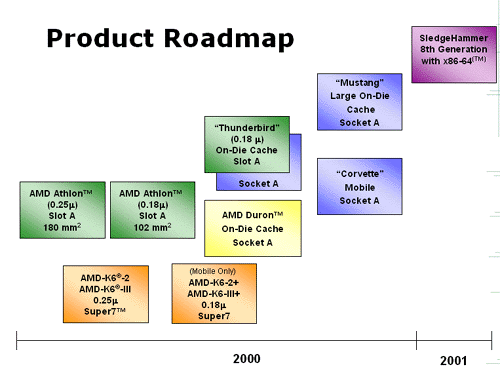AMD’s Voyage into the 64-bit Arena: x86-64 Revealed
by Anand Lal Shimpi on August 10, 2000 3:34 AM EST- Posted in
- CPUs
AMD's K8
Now it's time to get to the hardware side of things, while AMD isn't saying anything publicly about the forthcoming SledgeHammer processor, their first x86-64 CPU, we do have a gathering of what we know thus far about the elusive K8 and AMD's other high-end products.

For starters, the AMD760/770 chipsets are still due out for late this year as is AMD's first core specifically targeted at the high-end market, the Mustang. There is still no confirmation that the Mustang core will be shipping by the end of 2000 however, and there is a chance that it won't be until early 2001 that we really see the Mustang in its flesh. This is fine for AMD since the Thunderbird is already doing so well and its unlikely that we'll see volume shipments of Intel's Pentium 4 until early 2001 as well.
The first x86-64 based processors from AMD will be available sometime next year, this is contrary to rumors that we've seen pop up but realistically speaking, you're not going to see a SledgeHammer (K8) in 2000.
Like the current Athlon core, there will eventually be many variations on the K8 core. Most likely variations based on cache size, core clock frequency and maybe even FSB frequency will allow the x86-64 architecture to slowly but eventually filter down to non-enterprise applications.
The only issue we see at this point in time is chipset support for the K8. As of now, VIA is the biggest chipset provider for AMD's processors, but we can guarantee you that VIA, a company that is based around producing value chipsets, isn't going to be making enterprise level K8 chipsets. AMD's two other supporters in the chipset industry, ALi and SiS aren't even as big as VIA in the desktop chipset market right now, there's no way either of them will be supplying K8 chipsets, this leaves AMD to handle the task alone.
Developing and producing a chipset for such a high-end processor is not easy, it will definitely be much more difficult to implement than AMD's 750 was, and even then, the 750 was much more difficult than the BX chipsets motherboard manufacturers were used to playing with.
It should be interesting to see how the entire picture unfolds as there is much more to a successful processor than a solid architecture, although having the latter is definitely one step in the right direction.










1 Comments
View All Comments
Dr AB - Friday, May 8, 2020 - link
So that means indirectly, it was AMD's adoption decision/strategy that we see 32-bit only applications to this day. Hmm ... I wonder what if things had gone the other way.